Comments from the Chair
Welcome our new Executive Committees
I am pleased to announce the election results for three open positions for our Alamo Group Executive Committee (ExCom): Darby Riley (incumbent); Enrique Valdivia (incumbent); and Rene Watson (new member). I thank all those who served and volunteered for this election, and our Nominating Committee led by Peggy Day.
The Lone Star Chapter elected Martha Elena Pena, John Hertz (from San Antonio) and Craig Nazor to its ExCom. Whether elected or not, all are important, and I urge all to step forward in whatever way they can to help Sierra Club improve our environment.
Sierrans march in honor of Martin Luther King, Jr. and for climate action
About a dozen Alamo Group members responded to the call and joined this enormous march for social justice on January 21st. We were there especially to promote environmental justice and climate action now.
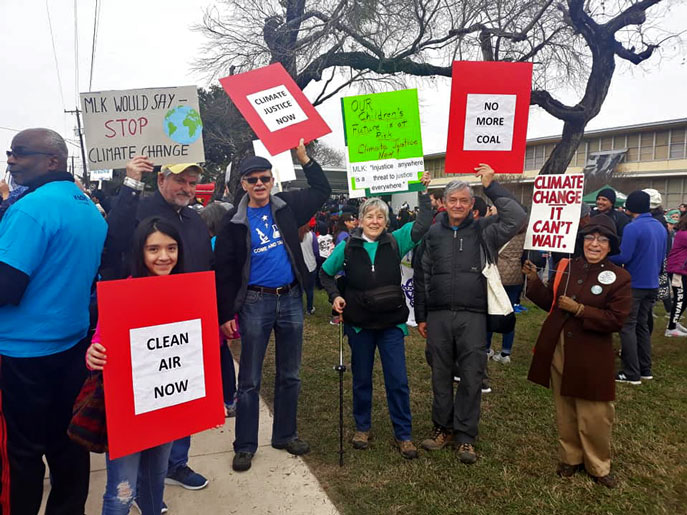
We got some good attention, carrying the Sierra Club banner with pride and holding high signs reading “Climate Justice Now”, “Climate Action Now”; “Clean Air Now”, “No More Coal”, etc. This was part of our effort to raise awareness about San Antonio’s Climate Action & Adaptation Plan released for public comment on Jan 25. In future marches, let’s turn out by the hundreds, or thousands!!.
Draft CAAP now open for comments
Since the summer of 2017, the City of San Antonio (CoSA), at the direction of the Mayor and Council, has been working on the development of a Climate Action & Adaptation Plan (CAAP) to address changes anticipated by climate science. Alamo Group leaders have been heavily involved in committee work in the development of this CAAP.
The first "Draft for Public Discussion" of the CAAP is now available, and public comments will be taken during a 30 day period ending February 24th. I encourage you to study the draft CAAP and complete this online survey.
Public support for a strong plan is urgently needed, especially for interim goals like shutting down Spruce coal plants by 2025.
Our publicly owned utilities are failing us
Our public utilities are failing us, and our City Council is failing to represent us with proper oversight of our utilities. We have struggled for several years to bring accountability and oversight to the “Public Private Partnership (P3)” that is the Vista Ridge Pipeline.
In the summer of 2017, right after the Mayoral and City Council elections we asked for “changes in water management, including a full review of the details of the Vista Ridge Project, review of the structure of the SAWS Board and its accountability to CoSA, reemphasis on water conservation, and more cooperation with CPS, and City Stormwater Department.”
We received no response from the Mayor or Council to this request, despite continued efforts since then. Likewise we have asked for more transparency from CPS for over 2 years, including Citizens to Be Heard at Board meetings, published meeting minutes, and a real Citizens Advisory Committee that meets openly, not in secret as it does now.
We have asked also for public participation in Board member selection and resource planning at CPS and SAWS. CPS has selected a second Board nominee in secret for the second time in less than a year, another person with financial and business acumen but no knowledge of the energy business, climate science, public health or non-business voices in our community. Therefore we must again oppose this nomination.
SAWS Board Chairman Berto Guerra is at the end of his legally limited second term, and no nomination process has begun because he wishes to continue on until Vista Ridge water flows (2020). This is not acceptable, violating the intent of term limits. It is time City Council take more active oversight of our utilities. We need to put the public back in our public utilities.
ConnectSA transportation plan released
A first draft Transportation/Mobility Plan has been released that is short on details and strikes me as unambitious at best. Rail is considered only to be rejected, assuming that previous negative votes make this option impossible.
This unrealistic thinking ignores the history of many other cities that rejected rail several times prior to finally accepting it. Those cities, including Dallas and Houston are now far ahead of us in developing comprehensive transit systems.
ConnectSA also offers no funding leadership to get us to a well funded system. Taking funds from our Edwards Aquifer Protection Program seems all wrong, robbing Peter to pay Paul.
The plan needs to get state cooperation so that our many state owned local roads can be fully included. TXDoT says it no longer will push for hundreds of miles of expanded highway lanes, finally recognizing what data analysis has shown for decades — these projects never solve congestion problems. State and local opposition to toll roads, an important component of mobility in other large cities, continues our distinction of having very high single occupancy vehicle travel, and vehicle miles traveled compared to other cities in Texas. Mobility in CoSA will be a major issue for San Antonio and the Sierra Club in local elections this year.
by Terry Burns, M.D., Alamo Group Chair
The City's Climate Action Plan

Your input to the City's climate plan is needed now! At our February Lions Field meeting, you can learn more about, and discuss, the City of San Antonio's Climate Action & Adaptation Plan (CAAP).
Thursday, February 28th
6:30 p.m.
Lions Field Adult Center, 2809 Broadway @ Mulberry
Map
The first "Draft for Public Discussion" was released on January 25th. During February, and into March, CoSA will be holding targeted stakeholder meetings and community-wide open houses.
We are pushing for a strong plan with specific goals and concrete implementation strategies. We need your support to achieve a strong CAAP. Visit the SA Climate Ready website to learn more about the plan and complete this online survey.
Since the summer of 2017, the City of San Antonio (CoSA), at the direction of the Mayor and Council, has been working on the development of a Climate Action & Adaptation Plan to address changes anticipated by climate science. Alamo Sierra Club leaders have been heavily involved in committee work in the development of this CAAP.
This meeting is free and open to the public.
JT Deely (1977-2018): Energy Dusk to Energy Dawn
Climate Action SA turns a funeral into a celebration while marking the last gasps of San Antonio’s oldest and dirtiest coal plant.
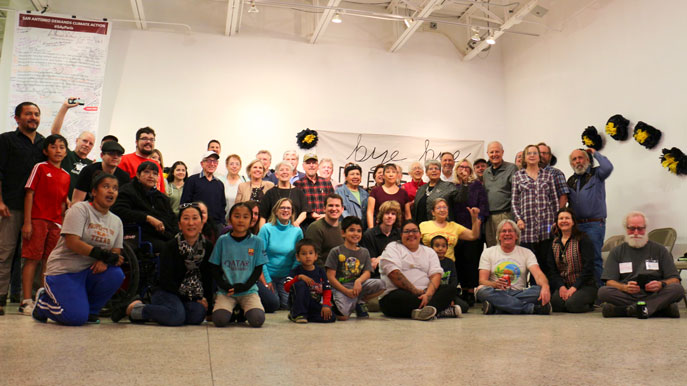
The tables were laid out with tamales and sangria (not to mention gluten-free vegan cupcakes), the walls covered in news articles telling a lengthy story of resistance. Inside Galería Guadalupe on San Antonio’s Westside, dancing feet shared time with celebratory speeches by community leaders, all to mark a momentous occasion: the beginning of the end of San Antonio’s coal age.
In just a matter of days — on December 31, to be precise — the City-owned utility would finally shutter 40-year-old, 840-megawatt J.T. “Dirty” Deely–and local residents, many of whom had dedicated years of concerted engagement to closing the plant, couldn’t wait to throw the behemoth a retirement bash.
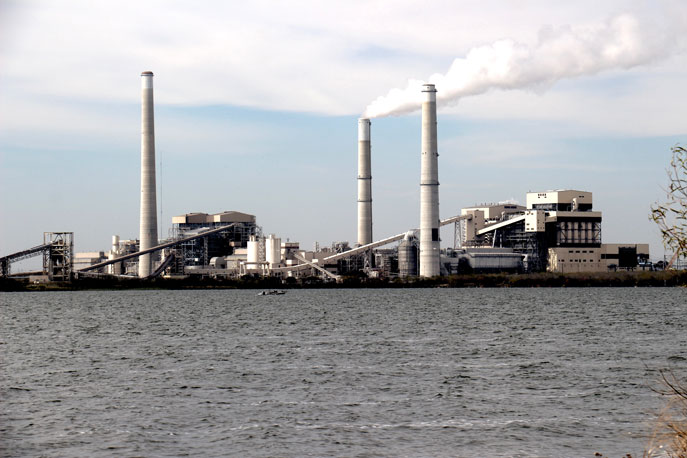
Efforts to shut down San Antonio’s oldest and dirtiest coal plant date back more than a decade and were cemented in a 2011 deal struck between the environmental community and former CPS Energy CEO Doyle Beneby, which allowed the utility to avoid paying millions for pollution-reduction technologies in exchange for early closure.
On December 15, nearly 200 celebrants from a wide swath of San Antonio’s environmental, climate, youth, and justice communities gathered for a four-hour “shutdown getdown,” an evening of potluck-swapped food and drink, coal-fight war stories, and dancing to the conjunto funk of Los Nahuatlatos and The Indigenauts.
As captured by the welcome text posted at the front of the gallery:
“We can’t take back the thousands of childhood asthma cases, premature deaths, and coal-connected heart attacks inflicted during these years of waiting. There’s no recalling the tens of millions of tons of globe-warming gases emitted between then and now.
“But what’s not to celebrate in the closure of a beast like this, the largest emitter in the San Antonio region of brain-poisoning lead and mercury? What’s not to dance to?”
Karla Aguilar of the Tap Pilam Coahuiltecan Nation offered the opening blessing, expressing “gratitude and encouragement to those of you who have been doing this work to shut down the Deely plant … and my prayers that it can be the first step in the right direction, to increase the dialogue in San Antonio and our region to understand that this is just the first step.”
Crucially, her blessing acknowledged that “all of those ones that are putting in the work have an understanding that the insurmountable cost of climate change is outrageously more than the growing pains of shifting to a green economy.”
A press conference followed, with multiple speakers emphasizing that while the Deely closure is a major victory for environmental justice and public health, it is more significantly a way station in the current, ongoing effort to force the city to craft a climate plan that commits to closing down all coal plants by 2025 and transitioning to all renewable energy by 2030. As stated by Briauna Barrera of Public Citizen and the Climate Action SA coalition:
“The battle to close Deely has been won, but the war for a fossil-free future continues. The City of San Antonio is leading an effort to create a climate plan, but a truly effective climate plan means shutting down all our coal plants and all of our natural gas infrastructure and rapidly transitioning to renewable energy. It means shifting priorities from those of endless growth to those of stability and sustainability. And it means redistributing resources.”
Shut down — get down
Following the blessing and press conference, a celebratory dirge and procession organized by climate justice artivist Alice Canestaro-Garcia and choreographed by decolonial dancer Fabiola Torralba officially kicked off the party, leading participants into the gallery space (see final few minutes of video above, after press conference speakers).
Yet as integral as fighting words or creative resistance were to the celebration, the heart of the event (for this liberation sociologist as least) was its documentation of the deep history bound up in the hearts and bodies of folks who participated, in many cases from the beginning, on the frontline of the long, slow struggle to close Deely.
Though we missed several oral histories, including those of long-time Sierra Club activists Loretta Van Coppenolle and Jerry Morrisey, here are two we did capture, one from Karen Hadden of the SEED Coalition (who discussed the Deely closure in the context of several other, overlapping dirty energy fights) and the second from environmental attorney Enrique Valdivia.
For video testimonies, see the online journal, Deceleration.news.
These testimonios were further complemented by a small exhibit posted to the gallery walls, compiled by Russell Seal and Peter Bella, with archival materials and photographs detailing the fight against Deely but also those against the younger J.K. Spruce coal plant and the South Texas Nuclear Project.
Listening to these stories, bumping into people we have worked alongside at various points but haven’t seen in years, remembering the intimacy of that work, recognizing those we know in photographs and newspaper articles, recognizing ourselves as a part of the histories recalled (and in some cases as documentarian)—we discover that if this is a story about energy descent, it is equally one about the long horizons of struggle and the relations of friendship and solidarity that emerge in the process.
And if it is an effort to document what happened and what we accomplished, it is also a reminder of how much of the story of that struggle remains within us, untold or unheard, to be recorded or written down or summoned forth in dance or song or prayer. And, equally, if it is the celebration of an ending, it is also the ceremonial recognition of what begins and continues—of the work that remains.
Requiem for a polluter
Deely’s last gasp arrived on December 31, 2018. A few of us got word of a TV truck prowling toward Calaveras Lake. New Year’s Eve champers in hand, we went into pursuit to make sure that local media, which had largely ignored the community story behind Deely’s demise, took proper notice. And as the News4 van returned to basecamp SA with a story of our lake-side toasting, we also doubled down with more of our own documentation.
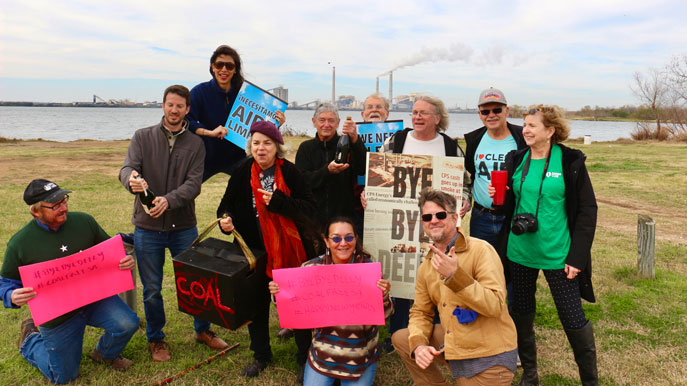
An interesting (and sobering) postscript has emerged from this hard-won local media coverage. Those who labored long and hard to close Deely fully expected that its post-retirement plans would be limited to fishing in Calaveras Lake (watch out for that mercury, tho) and engaging in karmic repair by volunteering with the American Lung Association. But as made clear in KSAT 12’s interview with current CPS Energy CEO Paula Gold-Williams, the city’s public utility is having a hard time letting go of the utility’s fossil fuel addiction—and an even harder time registering the community’s framing of Deely’s closure in terms of climate justice and public health rather than dollars and cents.
In spite of recent promises by CPS Chief Operating Officer Cris Eugster that CPS “will not be building a large base-load power plant again,” Gold-Williams has instructed staff to explore how much it would cost to convert the structure into … wait for it … a natural gas plant.
“We are having to do quite a bit of analysis,” she told KSAT reporter Sarah Acosta this week, “because once you use that footprint for coal, it’s pretty challenging to convert it to a gas unit. But we are looking at it to see if the economics of it do work to do something else with that unit.”
The former utility financial officer hasn’t quite gotten the lay of the land when it comes to the severity of our current climate crisis. Neither does she own up to the fact that coal kills.
Shutting down Deely, she told Acosta, was the right decision “from an environmental standpoint.” Not, we must point out, from a public health standpoint. And the future, she insists, “will be focused on gas and then new technologies coming down the pipe,” rather than the already existing clean-energy technology or carbon-free goals already under discussion in the city’s climate planning process.
And so, we continue. Another day; another tango.
The re-education of Paula Gold-Williams begins now.
by Marisol Cortez and Greg Harman, the Sierra Club's San Antonio Clean Energy Organizer. They are the co-editors of Deceleration.news.Blast from the Past: The Plan for a Dam at Dinosaur National Monument
In 1941 a plan was developed by the Bureau of Reclamation for a dam on the Green River at Echo Park in Dinosaur National Monument. This is an incredibly picturesque spot in far northwestern Colorado. The dam would have flooded the Green and Yampa Rivers through the national monument and what is now Browns Park National Wildlife Refuge to the north.
From the Wikipedia article: "The dam was bitterly opposed by preservationists, who saw the encroachment of a dam into an existing national park as another Hetch Hetchy, to be opposed as an appropriation of protected lands for development purposes. A compromise led to the abandonment of the Echo Park project in favor of Glen Canyon Dam on the main stem of the Colorado in lands that were not at that time protected." A map in the article shows the planned location of the dam to have been just downstream of Echo Park, so, to the left of, but out of, the picture below.
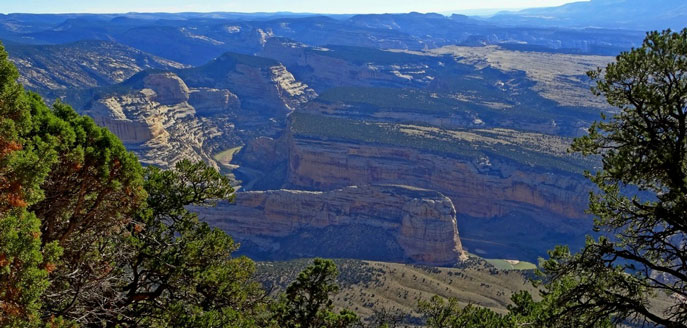
Check out the park website; here is the maps page and there is an extensive photo gallery. In addition to the viewpoints and roads there is the magnificent wall of partially excavated dinosaurs in the Quarry Exhibit Hall. Rafting is popular on the Green River; more on that in a future article.
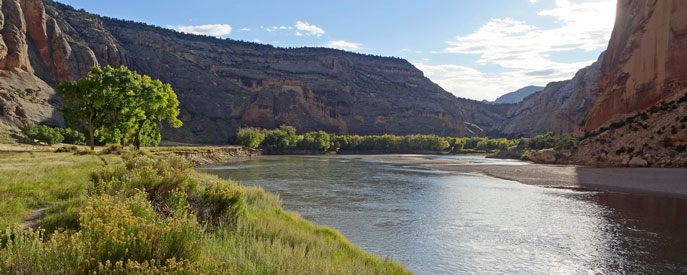
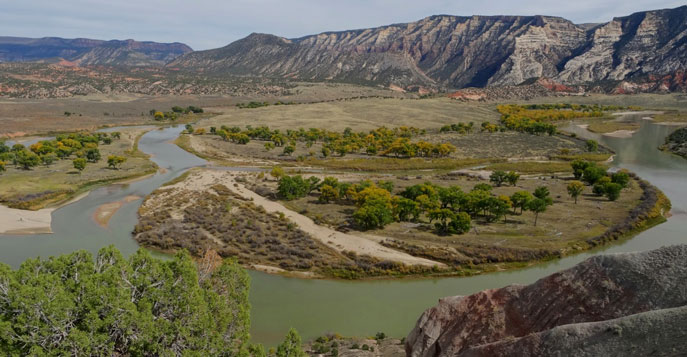
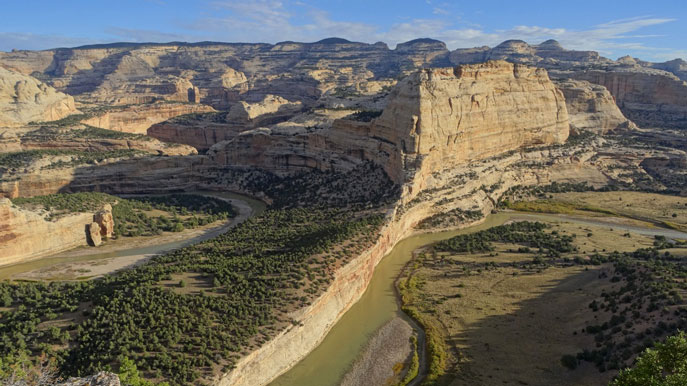
February General Meeting
The topic for our February general meeting will be announced on our web calendar.
Tuesday, February 19th
6:30 p.m. {refreshments served beginning at 6}
William R. Sinkin Eco Centro, 1802 North Main Avenue
Map
This event is free and open to the public.

Outings: The Call of the Wild
Visit the Alamo Sierra Club Outings page on Meetup for detailed information about all of our upcoming Sierra Club Outings.
The Alamo Sierran Newsletter
Richard Alles, Editor
Published by The Alamo Group of the Sierra Club, P.O. Box 6443, San Antonio, TX 78209, AlamoSierraClub.org.
The Alamo Group is one of 13 regional groups within the Lone Star Chapter of the Sierra Club.
Keep your email address current!
Send updates to Loyd Cortez, providing your name, address and membership number (if known).
Changed your mailing address?
Have you moved? Let us know by sending your old address, your new address and your member number (look on the upper left corner of your mailing label) to: address.changes@sierraclub.org.
Go online for the latest news and events
 |